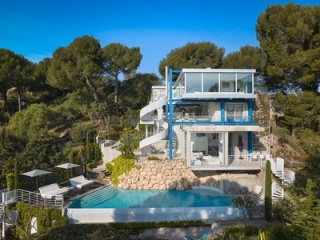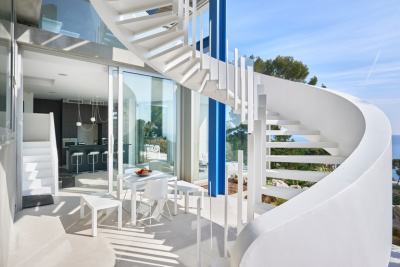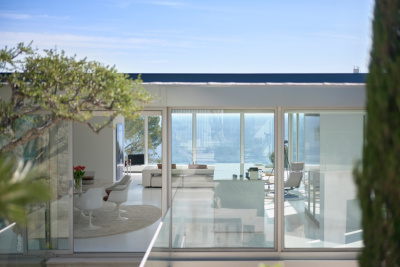Sotheby's International Realty
- 74 boulevard de la Croisette
- 06400 CANNES, France
- +33 4 92 92 12 88
Sotheby's International Realty
- 37 boulevard Marinoni
- 06310 BEAULIEU SUR MER, France
- +33 4 92 92 12 88
Sotheby's International Realty
- 3 avenue Denis Semeria
- 06230 SAINT JEAN CAP FERRAT, France
- +33 4 92 92 12 88
Sotheby's International Realty
- 9 avenue Paul Roussel
- 83990 SAINT TROPEZ, France
- +33 4 92 92 12 88
Sotheby's International Realty
- 5 rue Longchamp
- 06000 NICE, France
- +33 4 92 92 12 88
- Home
- >
- Luxury real estate
- >
- The Villa Ex (or Villa Bloc) by Claude Parent: An architectural icon on the Cap d'Antibes
The Villa Ex (or Villa Bloc) by Claude Parent: An architectural icon on the Cap d'Antibes

Cap d'Antibes is renowned for its beautiful scenery, heavenly beaches and rich history. In the middle of this unspoiled peninsula stands Villa Ex, an iconic piece of architecture designed by the renowned French architect Claude Parent. Villa Ex is not only a remarkable example of modern construction, but it also embodies the essence of Cap d'Antibes and its history.
Côte d'Azur Sotheby's International Realty offers this piece of history for vacation rental, for your discreet getaways to Cap d'Antibes.
The history of the villa
Built in 1993, Villa Ex is the result of a collaboration between Claude Parent and engineer Paul Virilio. Parent, known for his radical approach to architecture, created a bold and avant-garde structure.
This residence-workshop was built at the request of André Bloc, an engineer, painter, sculptor and director of the magazine "L'Architecture d'Aujourd'hui". It has several experimental aspects that give it its unique and striking appearance.
The villa also has an important significance in the history of architecture; indeed it is a perfect example of modernist architecture of the French Riviera and will be classified as a Historic Monument in 1989.
Its architectural inspiration
Following the preparation of a special issue of his magazine "L'Architecture d'Aujourd'hui" devoted to Ludwig Mies Van Der Rohe (1886-1969), André Bloc asked Claude Parent to create a metal structure in the form of a "bird's nest" inspired by the principles of the German architect for his house on the Cap d'Antibes.
The chosen site, located near the Garoupe lighthouse, is steep and not very adaptable to a traditional construction with bearing walls. The choice will therefore be, among others, that of the technique of IPN structures (I-beam) which gives this slender and linear aspect as well as reinforced concrete slabs. In this project, the client is also a consulting artist who participates in the design of the exterior staircase and plays on the contrasts created by its curves in relation to the geometric supporting structure.
A true manifesto of modern architecture, this house also raises the question of the adaptation of an innovative structure in an architectural environment characterized by a marked regionalist style, in this case the predominant style of the Cap d'Antibes - the Belle Epoque style.
Its architectural ambition
The architecture of Villa Ex is also marked by its harmonious integration with the surrounding natural landscape. Parent wanted the villa to blend into its plant and mineral environment, rather than dominate it.
The large windows offer a breathtaking view of the Mediterranean Sea, allowing residents to fully enjoy the beauty of Cap d'Antibes. The fluidity of the villa's structure, combined with its landscape integration, creates a sense of harmony between architecture and nature.
The design of Villa Ex reflects Parent's radical ideas on architecture. He pioneered the French architectural movement known as "béton brut," which advocated the use of unfinished, raw concrete to create innovative architectural spaces.
A block construction
The villa is characterized by a series of blocks stacked on top of each other, creating a sense of lightness and floating. The living spaces are arranged on different levels, each offering panoramic views of the Mediterranean Sea. The interiors are minimalist, with white walls, polished concrete floors and clean lines.
Today, Villa Ex is considered an architectural icon and continues to inspire architecture enthusiasts around the world. It is a reminder of the importance of pushing boundaries and rethinking conventions to create innovative and aesthetically pleasing spaces.
Its majestic presence on Cap d'Antibes is a testament to the history and beauty of this coastal region, capturing the imagination of visitors and residents alike.


Cap d'Antibes, host to the creative genius of artists
The architectural history of Cap d'Antibes dates back to Roman times, when the Romans built a villa on these picturesque grounds. However, the real architectural boom in the area came in the 19th century, when wealthy aristocrats and industrialists began to erect lavish mansions in a neoclassical style. The beautiful villas, surrounded by lush gardens and offering a breathtaking view of the Mediterranean Sea, were symbols of wealth and social status.
Over time, the architectural style of Cap d'Antibes has evolved to reflect the trends of each era. In the early 20th century, with the advent of Art Nouveau, many architects incorporated organic decorative elements and curved lines into the design of villas. Materials such as ceramics, wrought iron and glass were widely used to create original and elegant structures.
During the 1920s and 1930s, Cap d'Antibes became the resort of choice for Europe's elite, attracting such luminaries as Winston Churchill, Baron Rothschild and Prince Pierre of Monaco. Artists and writers such as F. Scott Fitzgerald, Ernest Hemingway and Pablo Picasso were also attracted by the spectacular scenery and pleasant climate of the area.
Villas built during this period reflected the architectural styles in vogue at the time, with lush gardens, ornate facades and sophisticated decorative elements.
The rise of modernism on the Cap d'Antibes
During the interwar period, modernism became a major influence in the architecture of Cap d'Antibes. Architects adopted clean lines, geometric shapes and a minimalist aesthetic. Modernist villas, characterized by white facades, large bay windows and flat roofs, began to emerge on the coast. Architects such as Le Corbusier, Eileen Gray and Richard Neutra designed innovative residences for the region. Claude Parent's Villa Ex fits perfectly into this tradition as a representation of modern architecture on the French Riviera.
Cap d'Antibes was also influenced by Bauhaus architecture, which gained popularity after World War II. This style emphasizes functionality, efficiency and the use of industrial materials. Many architects have adopted this approach to design contemporary homes that blend seamlessly into the natural landscape.
Today, Cap d'Antibes is an eclectic mix of architectural styles, ranging from historic villas to modern and contemporary homes. Wealthy residents and visitors continue to seek out unique properties that offer both idyllic settings and exceptional designs. The architectural style of Cap d'Antibes is a true showcase of the history and evolution of architecture over the centuries. Roman, neoclassical, Art Nouveau, modernist and Bauhaus influences have intermingled to create a remarkable architectural landscape.
This architectural diversity makes Cap d'Antibes a fascinating destination for architecture enthusiasts and lovers of timeless beauty. The Villa Ex is a perfect example of this and shines with its clarity and impressive volumes.
To learn more about its history and high-end amenities or to make it your vacation home, contact our Cannes vacation rental manager, Tarik Bouchenak, at the real estate agency on 74 Boulevard de la Croisette.
Contact us at :




